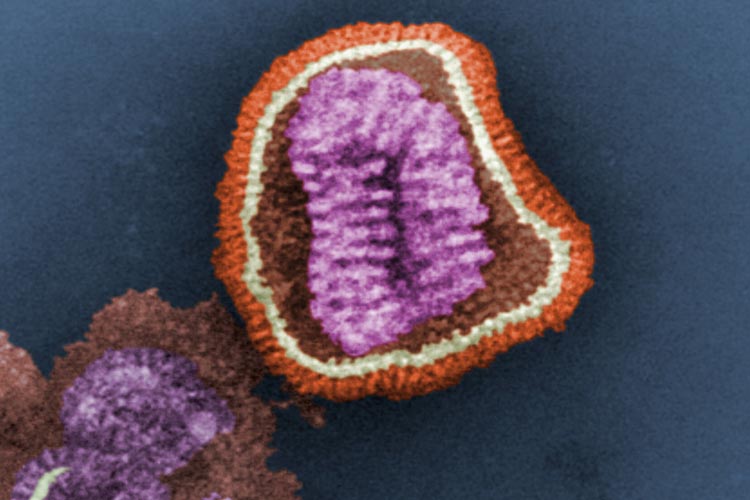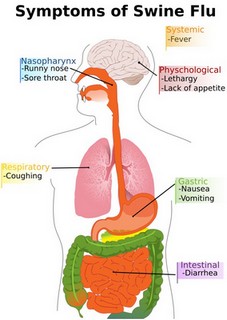Swine Flu Information
Swine influenza
Swine influenza (also called swine flu, swine influenza A or H1N1 flu) refers to influenza caused by any strain of the influenza virus endemic in pigs (swine). Strains endemic in swine are called swine influenza virus (SIV).
 Swine flu is common in swine but rare in humans. In the past, person-to-person swine flutransmission was very limited and usually not sustained beyond three people. However, in late March and early April 2009, cases of human infection with swine influenza virus were first reported in the U.S. The Centers for Disease Control and Prevention (CDC) has since confirmed that the virus is contagious and is spreading from human to human although it is not known how easily the virus spreads between people.
Swine flu is common in swine but rare in humans. In the past, person-to-person swine flutransmission was very limited and usually not sustained beyond three people. However, in late March and early April 2009, cases of human infection with swine influenza virus were first reported in the U.S. The Centers for Disease Control and Prevention (CDC) has since confirmed that the virus is contagious and is spreading from human to human although it is not known how easily the virus spreads between people.
Swine Flu Symptoms

According to the CDC, in humans the symptoms of swine flu are similar to thoseofinfluenza and of influenza-like illness in general. Symptoms include fever, cough, sorethroat, body aches, headache, chills and fatigue. The 2009 outbreak has shown an increased percentage of patients reporting diarrhea and vomiting.
Because these symptoms are not specific to swine flu, a differential diagnosis of probable swine flu requires not only symptoms but also a high likelihood of swine flu due to the person's recent history. For example, during the 2009 swine flu outbreak in the United States, CDC advised physicians to "consider swine influenza infection in the differential diagnosis of patients with acute febrile respiratory illness who have either been in contact with persons with confirmed swine flu, or who were in one of the five U.S. states that have reported swine flu cases or in Mexico during the 7 days preceding their illness onset."[21] A diagnosis of confirmed swine flu requires laboratory testing of a respiratory sample (a simple nose and throat swab).
Prevention of spread in humans
Influenza spreads between humans through coughing or sneezing and people touching something with the virus on it and then touching their own nose or mouth. Swine flu cannot be spread by pork products, since the virus is not transmitted through food. The swine flu in humans is most contagious during the first five days of the illness although some people, most commonly children, can remain contagious for up to ten days. Diagnosis can be made by sending a specimen, collected during the first five days for analysis.Recommendations to prevent spread of the virus among humans include using standard infection control against influenza. This includes frequent washing of hands with soap and water or with alcohol-based hand sanitizers, especially after being out in public. Although the current trivalent influenza vaccine is unlikely to provide protection against the new 2009 H1N1 strain, vaccines against the new strain are being developed and could be ready as early as June 2009.
Experts agree that hand-washing can help prevent viral infections, including ordinary influenza and the swine flu virus. Influenza can spread in coughs or sneezes, but an increasing body of evidence shows small droplets containing the virus can linger on tabletops, telephones and other surfaces and be transferred via the fingers to the mouth, nose or eyes. Alcohol-based gel or foam hand sanitizers work well to destroy viruses and bacteria. Anyone with flu-like symptoms such as a sudden fever, cough or muscle aches should stay away from work or public transportation and should see a doctor to be tested.
Social distancing is another tactic. It means staying away from other people who might be infected and can include avoiding large gatherings, spreading out a little at work, or perhaps staying home and lying low if an infection is spreading in a community. Public health and other responsible authorities have action plans which social distancing actions to request or require depending on the severity of the outbreak.
Treatment In humans
If a person becomes sick with swine flu, antiviral drugs can make the illness milder and make the patient feel better faster. They may also prevent serious flu complications. For treatment, antiviral drugs work best if started soon after getting sick (within 2 days of symptoms). Beside antivirals, palliative care, at home or in the hospitals, focuses on controlling fevers and maintaining fluid balance.The U.S. Centers for Disease Control and Prevention recommends the use of Tamiflu (oseltamivir) or Relenza (zanamivir) for the treatment and/or prevention of infection with swine influenza viruses, however, the majority of people infected with the virus make a full recovery without requiring medical attention or antiviral drugs. The virus isolates in the 2009 outbreak have been found resistant to amantadine and rimantadine.
Infectious Period
Persons with swine influenza A (H1N1) virus infection should be considered potentially contagious for up to 7 days following illness onset. Persons who continue to be ill longer than 7 days after illness onset should be considered potentially contagious until symptoms have resolved. Children, especially younger children, might potentially be contagious for longer periods. The duration of infectiousness might vary by swine influenza A (H1N1) virus strain. Non-hospitalized ill persons who are a confirmed or suspected case of swine influenza A (H1N1) virus infection are recommended to stay at home (voluntary isolation) for at least the first 7 days after illness onset except to seek medical care.Protection from swine flu
In areas with confirmed human cases of swine influenza A (H1N1) virus infection, the risk for infection can be reduced through a combination of actions. No single action will provide complete protection, but an approach combining the following steps can help decrease the likelihood of transmission. These actions include frequent handwashing, covering coughs, and having ill persons stay home, except to seek medical care, and minimize contact with others in the household. Additional measures that can limit transmission of a new influenza strain include voluntary home quarantine of members of households with confirmed or probable swine influenza cases, reduction of unnecessary social contacts, and avoidance whenever possible of crowded settings.When it is absolutely necessary to enter a crowded setting or to have close contact with persons who might be ill, the time spent in that setting should be as short as possible. If used correctly, facemasks and respirators may help reduce the risk of getting influenza, but they should be used along with other preventive measures, such as avoiding close contact and maintaining good hand hygiene. A respirator that fits snugly on your face can filter out small particles that can be inhaled around the edges of a facemask, but compared with a facemask it is harder to breathe through a respirator for long periods of time.
When crowded settings or close contact with others cannot be avoided, the use of facemasks or respirators in areas where transmission of swine influenza A (H1N1) virus has been confirmed should be considered.
Additional Recommendations:
INDIVIDUALS
- Avoid close contact with people who are sick. Stay at home when you are sick or have flu symptoms. Cover your mouth and nose with a tissue when coughing or sneezing. Wash your hands. Avoid touching your eyes, nose or mouth.
Talk over what your family would do in a pandemic. Who would care for children or people with special needs if everyone is sick? Keep basic health supplies on hand: soap or alcohol-based hand wash, fever reducers, fluid with electrolytes and tissues. - Because schools may close, consider pooling child care resources with neighbors, and ask schools about their back-up plans.
- Talk to your employer about telecommuting or working from home. Public transportation may be disrupted, so consider car-pooling options for all transportation needs.
BUSINESSES
- Make sure pandemic plans address long-term absenteeism rates. Ask what are the company's essential functions -- accounting, payroll, and information technology -- and identify people who perform them. Cross-train employees on these functions.
- Plan for interruptions of essential government services like sanitation, water, power and transportation, or disruptions to the food supply.
- Update sick leave and family and medical leave policies and communicate with employees about the need to stay home from work. Expand tools that enable employees to work from home with appropriate security and network access to applications.
- Maintain a healthy work environment, with good air circulation. Post tips on how to stop the spread of germs at work. Ensure wide and easy access to hand sanitizers.
- Tell employees about the threat of pandemic flu and the steps the company is taking to prepare for it.
COMMUNITY AND FAITH-BASED ORGANIZATIONS:
- Consider how an influenza pandemic would affect regular activities and services. Think about circumstances that may require you to increase, decrease or stop the services your organization delivers.
- Update sick leave and family and medical leave policies so staffers will not be penalized for personal illness or for caring for sick family members during a pandemic.
- Instruct volunteers and employees to remain home until they are well.
See if volunteers and staff have cross-over skills like nursing or mental health counseling that could be used during a health crisis, and make that information known to local health authorities. - Modify activities that involve person-to-person contact, such as religious rites that involve sharing drink from common glasses or holding hands.
Back to the Swine Flu Home Page

